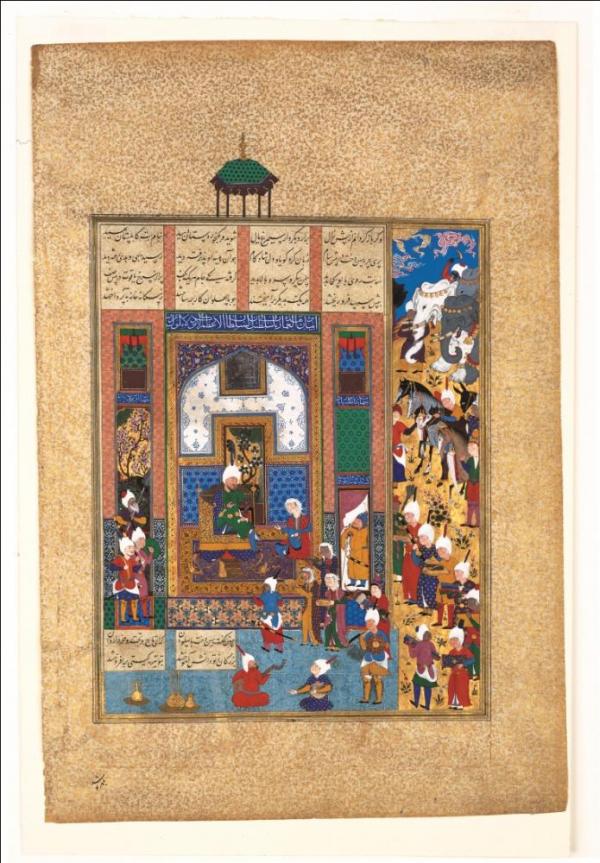
An Iranian illustration from the early 16th century

An Iranian illustration from the early 16th century
Long before art is given to a museum and displayed, it possesses its own unique story that is often overlooked in favor of discussions of artistic style or relevance.
Many works were given as gifts, with each exchange bearing a small, but oftentimes fascinating, piece of history. The National Endowment for the Humanities-supported exhibit Gifts of the Sultan: The Arts of Giving at the Islamic Courts, organized by the Los Angeles County Museum of Art (LACMA) and the Museum of Fine Arts, Houston (MFAH), places the history of individual art works at the forefront by examining the relationship between artistic production and gift exchange.
One of the exhibit’s treasures, the double-page painting Presentation of Gifts by the Safavid Ambassador to Selim II at Edirne, seems to depict nothing more than the reception of the emissary of the Safavid shah Tahmasp (r. 1524-76). The Iranian envoy presents the Ottoman Sultan with beautiful gifts – gilded Qur’ans, textiles, rolled carpets, and more – each item an artistic treasure.
Beneath the surface of the seemingly gracious visit, however, the gifts communicate other meanings. The offerings include an old illustrated Qur’an and the famed Shahnama (Book of Kings) manuscript, originally containing 258 illustrations that are now scattered among collections throughout the world. In addition to the beautiful calligraphy and illustrations, and perhaps more importantly for the Iranian envoy, the manuscripts stress the religious legitimacy of the Shiite Muslims, compared with the ruling Sunni Ottomans. It is a precious, but calculated, gift intended to convey a particular message.
With an eye towards Islamic art, the exhibit places the subtleties of gift exchange at the forefront. It is divided into three sections – personal gifts, pious donations, and diplomatic offerings – featuring some 250 works of art, including jewelry, textiles woven with golden thread, and silk carpets. Spanning the eighth through the nineteenth centuries, the exhibit traces gift exchanges between Islamic and Byzantine, western European, and eastern Asian courts.
The exhibit brings together artifacts from forty institutions worldwide, such as the 1633 folio Shah Jahan Receives the Persian Ambassador, Muhammad 'Ali Beg, from the collection of Queen Elizabeth II. LACMA reaches into its own collection for items such as the famed and rarely exhibited sixteenth-century Ardabil Carpet. The beautifully ornate carpet, originally a royal gift to the Safavid shrine at Ardabil in northwestern Iran, was itself given as a gift to LACMA by J. Paul Getty.
The exhibit also includes contemporary works on the exhibit’s theme by artists with roots in the Islamic world.
The exhibit is scheduled to run from June 5, 2011, through -September 5, 2011, at LACMA and October 23, 2011, through January 15 2015 at the Museum of Fine Arts in Houston.
To access LACMA’s webpage on the exhibit, click here [http://www.lacma.org/art/exhibition/gifts-sultan-arts-giving-islamic-courts].